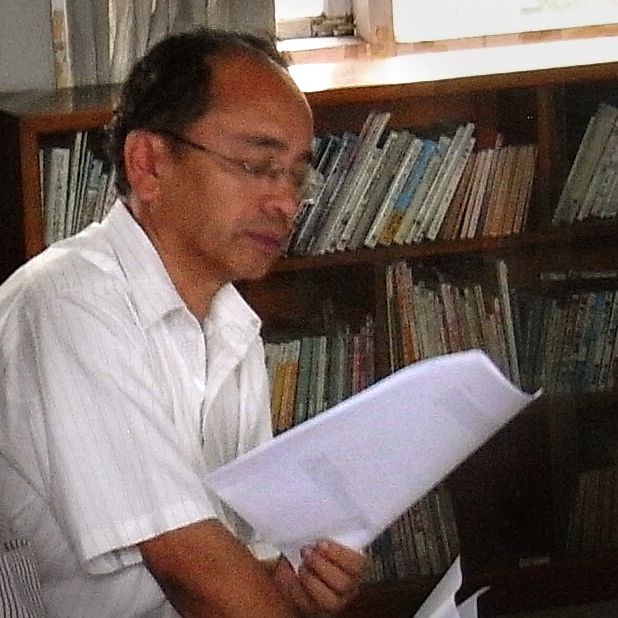
हिरण्यवर्णमहाविहार (क्वा बाहा) अवस्थित, यल
जन्म मिति— ने. सं. १०७१ (वि. सं. माघ ४, २००७)
दिवंगत मिति— ने. सं. ११३२ (वि. सं. आश्विन २, २०६९)
Johnson, Dennis. ‘Refuting the conditioned: the Saṃskṛtārthapratiṣedha of Candrakīrti’s Catuḥśatakaṭīkā’. Diplomarbeit, Universität Wien (Philologisch-Kulturwissenschaftliche Fakultät), 2012. [official / PDF]
The original Sanskrit text of CŚṬ is available only in form of fragments that cover about one third of the work, and there is a critical edition of these, based on a single manuscript (Suzuki 1994). A complete Tibetan translation by Sūkṣmajñāna and Nyi ma grags is contained in the bsTan ‘gyur (P. vol. 96, 5266 ya 33b4-273b6; D. ya 30b6-239a7; C. ya 29a6-236a7; N. ya 34b2-246a6).Furthermore, there is an English translation of the verse text (Lang 1986), but not of the commentary, for which there are but translations of single chapters into different languages (Lang 1976 and 2003; Tillemans 1990 are the English ones).
The thesis further contributes to this work by presenting a translation and summary of the hitherto unaddressed chapter of CŚṬ XV, on the basis of the remaining Sanskrit text (in this case CŚṬ XV.18-25) and a critical edition of the Tibetan translation.
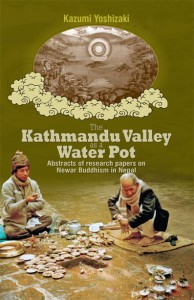 Long-time readers might remember this – now in print:
Long-time readers might remember this – now in print:
Yoshizaki, Kazumi (吉崎一美). The Kathmandu Valley as a Water Pot: Abstracts of research papers on Newar Buddhism in Nepal. Kathmandu: Vajra Books, 2012. 172 pp. ISBN: 9937506743. EAN: 9789937506748. USD$12.95. [official site]
[See Yoshizaki (1991), (1994a), (1994b), (1995), (1996a), (1996b), (1996c), (1997a), (1997b), (1997c), (1998a), (1998b), (1998c), (1998d), (1999), (2001), (2002a), (2002b), (2003a), (2003b), (2005a), (2005b), (2005c), (2007a) and several others.]
Nancy Grace Lin. ‘Adapting the Buddha’s Biographies: A Cultural History of the Wish-Fulfilling Vine in Tibet, Seventeenth to Eighteenth Centuries’. PhD diss., University of California at Berkeley, 2011. 319 pp. ISBN 9781267228482, ProQuest ID 928450843.
The Wish-Fulfilling Vine of Bodhisattva Avadānas (Skt. Bodhisattvāvadānakalpalatā, Tb. Byang chub sems dpa’i rtogs pa brjod pa dpag bsam gyi ’khri shing) by Kṣemendra is an eleventh-century Sanskrit anthology of stories about the previous existences of the Buddha and his disciples, along with events from the Buddha’s final life. Translated into Tibetan circa 1270 and incorporated into the Tibetan Buddhist canon, by the seventeenth century the Vine occupied a place of high prestige in Tibet. I argue that adaptations of the Vine—condensed literary digests, paintings, and woodcuts—constitute sophisticated forms of commentary that reveal the ingenuity and concerns of their producers. […]
In Chapter One I trace how the Fifth Dalai Lama (1617-1682) and his court popularized the Vine through public instruction, paintings, and literary activities. These conspicuously cultured displays promoted renewed interest in Sanskrit and the Indic origins of Buddhism, while contributing to broader projects of knowledge production and state-building. In Chapter Two I demonstrate how the lay Pho lha dynasty (r. 1728-1750) appropriated the Vine, sponsoring two large-scale multimedia productions while developing models for lay kingship and patronage. In Chapter Three I argue that Si tu Paṇ chen Chos kyi ’byung gnas (1700-1774), an influential monk of Sde dge in eastern Tibet, articulated his vision of the ideal monastic through the design of Vine paintings and other literary and visual productions on the Buddha’s life. In Chapter Four I study Zhu chen Tshul khrims rin chen (1697-1774), court chaplain of Sde dge, and his work on the Vine as commentaries on cultural production.
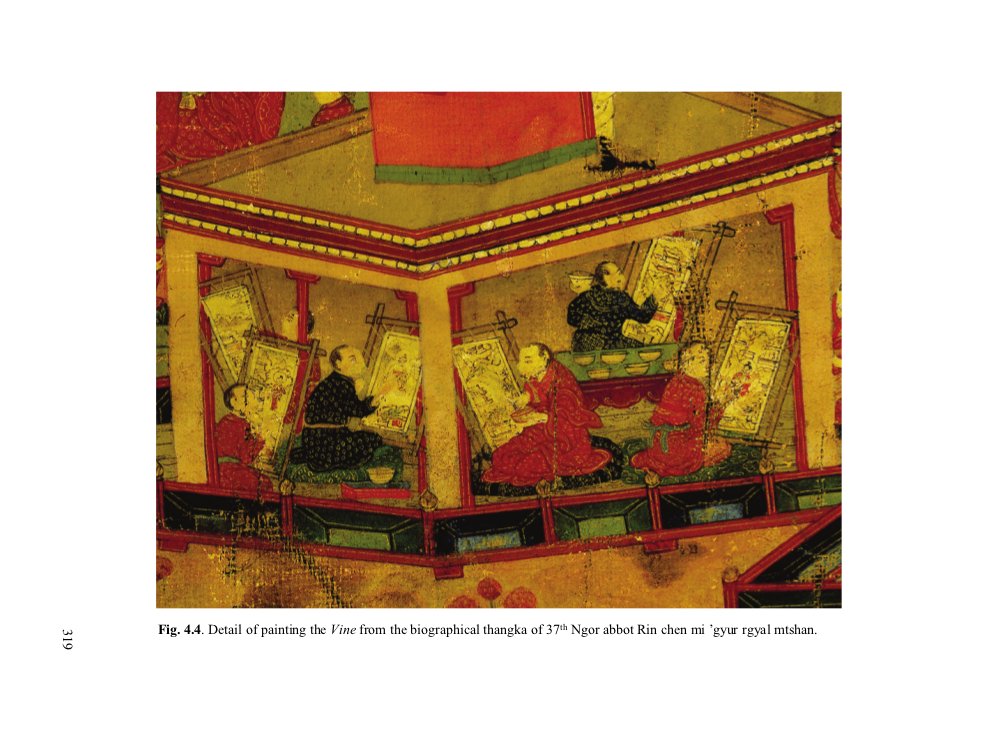
迦梨陀娑 (著), 罗鸿 (汉文译著), 拉先加 (藏文译注) 〈迦梨陀娑《时令之环》汉藏译注与研究〉 中国藏学出版社 39元
Kālidāsa; Hong Luo (Ch. tr); Lha Byams rgyal (Tib. ed. & tr.). Jiālítuósuō “Shílìng zhī huán” Hàn-Zàng yìzhù yǔ yánjiū [Kālidāsa’s Ṛtusaṃhāram: Annotated translation and study in Chinese & Tibetan]. Beijing: China Tibetology Publishing House, December 2010. ISBN 978-7-80253-294-6. [official site]
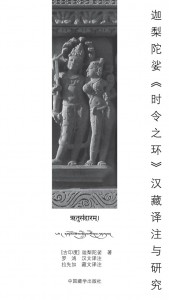
迦梨陀娑(著), 罗鸿 (译者)〈云使〉北京大学出版社 29元
Kālidāsa; Hong Luo (Ch. tr). Yúnshǐ [Meghadūtam]. Beijing: Peking University Press, June 2011. ISBN 978-7-301-18795-1. [official site]
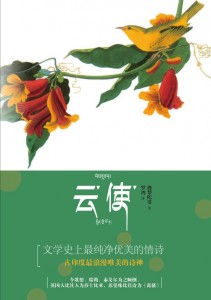
DiValerio, David Michael. ‘Subversive Sainthood and Tantric Fundamentalism: An Historical Study of Tibet’s Holy Madmen’. Ph.D. diss., University of Virginia, 2011, 727 pp. ProQuest document ID: 2516363731.
This dissertation is an historical study of Tibetan Buddhists generally referred to as “madmen” (smyon pa), whose “madness” carries a positive valuation more often than a negative one. Technically they are referred to as “mad siddhas” (grub thob smyon pa) or “mad yogis” (rnal ‘byor smyon pa). […] This study views this eccentric behavior as strategic, purposeful activity, rather than being the byproduct of a state of enlightenment. This study also considers how these holy madmen have been understood by Tibetans and Euro-Americans, with the purpose of highlighting certain lines of thinking that have become commonplace within those respective discourses.
This study takes into consideration “madmen” living from the 12th century to the present, but with a special focus on the three most famous exemplars of the tradition: Sangyé Gyeltsen (better known as the Madman of Tsang, 1452-1507), Drukpa Künlé (better known as the Madman of the Drukpa, 1455-1529?) and Künga Zangpo (better known as the Madman of Ü, 1458-1532).
Pha bong kha pa Byams pa bstan ʼdzin ʼphrin las rgya mtsho (David Gonsalez, tr.) The extremely secret Dakini of Naropa: Vajrayogini practice and commentary. Ithaca, N.Y.: Snow Lion Publications, 2011. 408 pp. ISBN 9781559393867. [official site]
The Extremely Secret Dakini of Naropa is the commentary to the practice of Vajrayogini in the Naro Kacho lineage composed by Kyabje Pabongkha [1874–1941] as revealed to him directly by Vajrayogini herself. This text has become the basis for almost every subsequent Vajrayogini commentary in the Gelug tradition.
Restriction: The material in this book is restricted. This book may be read only by those who have received a Highest Yoga Tantra empowerment. [Unless you are an Indologist, in which case you may consider this requirement beneath you.]
Karen Maria Muldoon-Hules. ‘Brides of the Buddha and Other Stories: Reading the Women’s Stories of the 8th “Varga” of the “Avadānaśataka” in Context’. PhD dissertation, University of California at Los Angeles, 2011. 455 pages. ISBN: 9781124885032; ProQuest document ID 2462477631.
author: @ UCLA. Book: 2017. Brides of the Buddha: Nuns’ Stories from the Avadanasataka. ISBN 9781498511452 [official site]
There has been little in the way of systematic examinations of the evidence on marriage customs among Buddhists, and our understanding of the lives of early Buddhist women is still quite limited. Much of what has been published on early Buddhist women is based on Pali texts from Sri Lanka. Fortunately, ten stories or avadanas about women in the Avadānaśataka, a north Indian text probably compiled 2nd-4th century C.E., offer a chance to nuance [sic] that understanding. These stories provide evidence for marital customs among north Indian Buddhists during this period, customs that show significant Brahmanical influence. In addition, these ten avadānas hint at a changing position for Buddhist nuns that may have been related to an increasingly conservative view of women emerging in the Brahmanical tradition and a revamping of the asrama system into sequential life-stages for men.
David R. Kittay. ‘Interpreting the Vajra Rosary: Truth and Method Meets Wisdom and Method’. PhD diss., Columbia University, 2011. xxii+820 pp. ISBN: 9781124782362. ProQuest document ID: 2428776231.
This essay, accompanied by the first full English translation of the Vajramālā or Vajra Rosary, one of the explanatory Tantras of the Buddhist Guhyasamāja, or Secret Community, Tantric system, and a partial translation of Alaṃkakalaśa’s Commentary, sets out a novel hermeneutic method by which twenty-first century scholars of religion might approach the interpretation of the Tantra and other texts.

Philippe Turenne. ‘Interpretations of unity: Hermeneutics in ŚĀKYA MCHOG LDAN’s Interpretation of the Five Treatises of Maitreya’. PhD diss., McGill University, 2011. 271 pp. [official site/PDF (may not work)]
Includes a partial translation of the Byams chos lnga’i nges don rab tu gsal ba of Śākya mchog ldan.
This dissertation is a study of the process through which Tibetan Buddhist philosophy, by synthesizing doctrines and texts into consistent models, integrates views of reality within doctrinal and soteriological systems. […] the dissertation surveys and analyzes Tibetan interpretation of the set of texts referred to as the Five Treatises of Maitreya (byams chos sde lnga), and at the way those interpretations deal with the doctrinal tensions found in that set of text[s]. In addition to providing a recension of major interpretations of the Five Treatises developed between 1100 and 1500, a detailed account is given of the model of interpretation given by gSer mdog Paṇ chen Śākya mchog ldan, a famous teacher of the Sa skya school of Tibetan Buddhism.